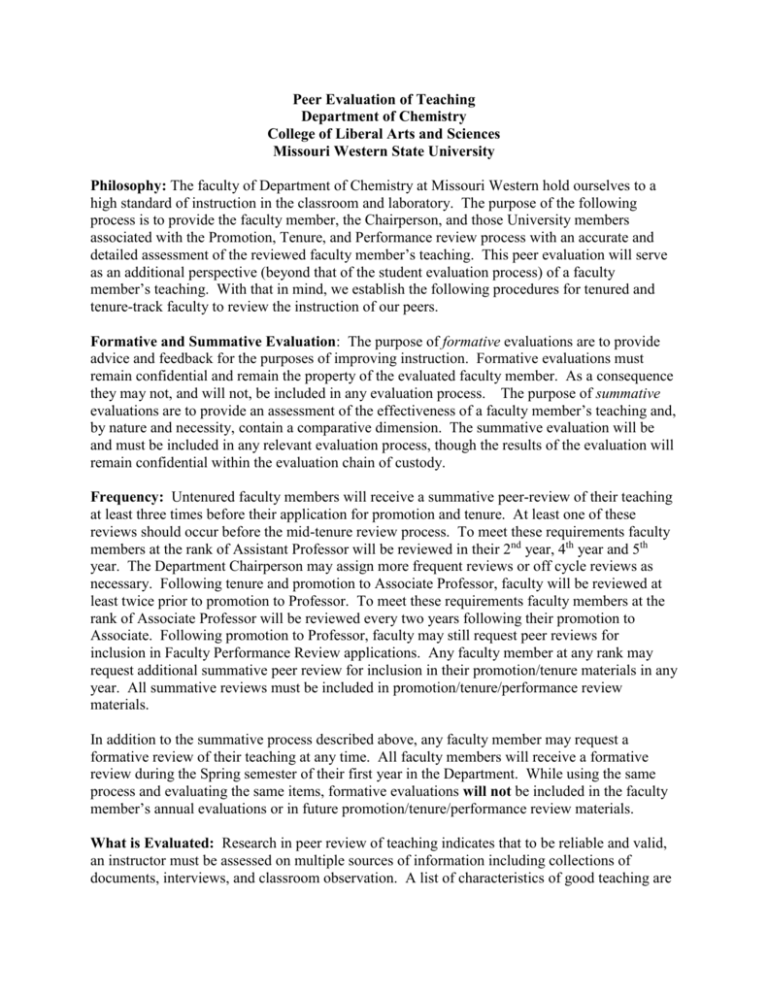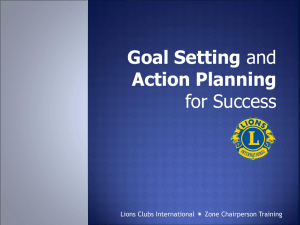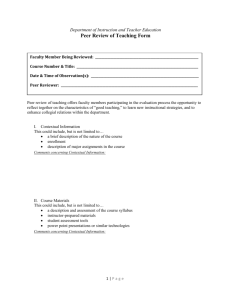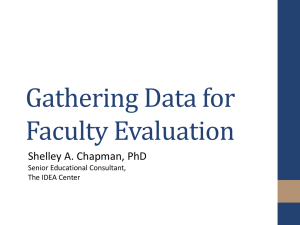Chemistry - Missouri Western State University
advertisement

Peer Evaluation of Teaching Department of Chemistry College of Liberal Arts and Sciences Missouri Western State University Philosophy: The faculty of Department of Chemistry at Missouri Western hold ourselves to a high standard of instruction in the classroom and laboratory. The purpose of the following process is to provide the faculty member, the Chairperson, and those University members associated with the Promotion, Tenure, and Performance review process with an accurate and detailed assessment of the reviewed faculty member’s teaching. This peer evaluation will serve as an additional perspective (beyond that of the student evaluation process) of a faculty member’s teaching. With that in mind, we establish the following procedures for tenured and tenure-track faculty to review the instruction of our peers. Formative and Summative Evaluation: The purpose of formative evaluations are to provide advice and feedback for the purposes of improving instruction. Formative evaluations must remain confidential and remain the property of the evaluated faculty member. As a consequence they may not, and will not, be included in any evaluation process. The purpose of summative evaluations are to provide an assessment of the effectiveness of a faculty member’s teaching and, by nature and necessity, contain a comparative dimension. The summative evaluation will be and must be included in any relevant evaluation process, though the results of the evaluation will remain confidential within the evaluation chain of custody. Frequency: Untenured faculty members will receive a summative peer-review of their teaching at least three times before their application for promotion and tenure. At least one of these reviews should occur before the mid-tenure review process. To meet these requirements faculty members at the rank of Assistant Professor will be reviewed in their 2nd year, 4th year and 5th year. The Department Chairperson may assign more frequent reviews or off cycle reviews as necessary. Following tenure and promotion to Associate Professor, faculty will be reviewed at least twice prior to promotion to Professor. To meet these requirements faculty members at the rank of Associate Professor will be reviewed every two years following their promotion to Associate. Following promotion to Professor, faculty may still request peer reviews for inclusion in Faculty Performance Review applications. Any faculty member at any rank may request additional summative peer review for inclusion in their promotion/tenure materials in any year. All summative reviews must be included in promotion/tenure/performance review materials. In addition to the summative process described above, any faculty member may request a formative review of their teaching at any time. All faculty members will receive a formative review during the Spring semester of their first year in the Department. While using the same process and evaluating the same items, formative evaluations will not be included in the faculty member’s annual evaluations or in future promotion/tenure/performance review materials. What is Evaluated: Research in peer review of teaching indicates that to be reliable and valid, an instructor must be assessed on multiple sources of information including collections of documents, interviews, and classroom observation. A list of characteristics of good teaching are included in Appendix A of this document. The following items will be considered in the evaluation: - Written Statement of Teaching Philosophy - Course Syllabi - Classroom/laboratory observation - Examples of course materials (homework, exams, worksheets, etc.) - Samples of student work Reviewing Faculty: Peer review of teaching will be conducted by a tenured faculty member, unless extenuating circumstances arise that prevent it. Only under unusual conditions will a faculty member outside the Department of Chemistry be assigned to conduct a summative review. No more than one peer review for any application shall come from the Department Chairperson. In cases of summative evaluations, the Department Chairperson will assign a reviewer. Assignments will be distributed on or before the first day of classes in the Fall semester. Both the reviewer and the reviewed will be notified of the assignments. Review Process and Timeline: - Both the reviewing faculty member and the faculty member to be reviewed will be notified of the need for a summative review on or before the first day of Fall term classes. - The reviewing faculty member and the faculty member to be reviewed will meet within the first two weeks of the Fall term to determine when the review will take place and in what course(s). Reviews should occur during the Fall semester, though may occur in the Spring term following consultation with the Chairperson. - The review process should consist of a minimum of three meetings and a classroom/laboratory observation. o Meeting 1: The faculty member will identify what course(s) they would prefer to have reviewed and will share general course philosophy, syllabi, and sample assessment components with the reviewer. An agreement must be made on what date the class(s) will be observed. The faculty member should describe what the goals and activities of the reviewed class period will be. If a faculty member is teaching in a variety of formats (lecture, laboratory, on-line, etc.) each format should be evaluated over the course of a promotion period. Ideally these would be evaluated in total each time to provide a more complete picture of the faculty members teaching skill set. That is, if a faculty member is teaching both lectures and labs in the same term then one lecture section would be observed and one lab section would be observed in the same term. o Classroom Observation: On the agreed upon date the reviewing faculty member will attend a lecture/laboratory period to observe classroom related skills. The Classroom Observation Form (Appendix B) will be completed during/ immediately after the observation. o Meeting 2: Within one week of the classroom/laboratory observation the reviewer and reviewed will meet to discuss how the observed period went. The faculty member will have the opportunity to describe what went well and what challenges were experienced. They should also identify what they might change to improve the lesson for the next iteration. o Meeting 3: Within 3-weeks of the observation the reviewer and reviewed should meet to discuss the evaluation. A copy of the evaluation will be submitted to the Department Chairperson for inclusion in the Faculty Members permanent record. If desired the reviewed faculty member may file a letter of clarification/rebuttal with the Department Chairperson. This letter will be attached to the review and will move forward as part of the document for any review purposes (i.e., Annual Evaluation, Promotion, FPR, etc.) Observation Rubric: The in class observation of faculty members will be recorded using the form found in Appendix B of this document. While this form may be referred to during meetings with the faculty member, the form will not be forwarded as part of the formal written summative review. Rather it is to serve as a tool to guide and provide a record of the observation. Review/Evaluation: Prior to the third meeting, the reviewer will write a narrative describing the meetings, review of materials, and classroom/laboratory observations. The review must provide positive feedback as well as suggestions for improvement. Emphasis should be placed on the positive aspects of the faculty member’s teaching. The reviewer will consider the following criteria at a minimum: clarity, organization, preparedness, and appropriate breadth/depth, balance of theory and practice, student engagement. Specific examples of each of these items must be presented. The reviewer will also complete Appendix C: Missouri Western State University Peer Evaluation of Teaching matrix. The completed matrix and the written review will constitute the complete summative evaluation. Two copies of the evaluation should be prepared. Submission: One copy of the evaluation will be returned to the reviewed faculty member and a second copy sent to the Chairperson. Reviews will be submitted to the Department Chairperson and the reviewed faculty member within 2 weeks third meeting. The reviewed faculty member will then have a three week window in which to submit a letter of clarification/rebuttal if they so desire. Appendix A: Characteristics of Effective Teaching (http:www.celt.iastate.edu/pet/) Person as Teacher - Is skilled at communicating - Has a positive attitude toward students - Exhibits respect for all students Content Knowledge Expert - Is capable of using relevant information from literature in teaching - Has thorough knowledge of subject - Has knowledge of new developments/advanced in subject Facilitator of learning processes - Places the student at the center when designing educational material - Is capable of designing activating educational materials - Is capable of building education in such a way that students gradually learn to learn in a self-directed manner. - Is capable of giving feedback - Places the student at the center of his/her teaching - Is capable of activating students - Is capable or assessing student’s learning results - Is capable of re-adjusting his/her practice on the basis of evaluations - Is capable of designing tests that are appropriate for the desired learning results. Organizer - Is capable of cooperating with colleagues. - Is communicative when cooperating with colleagues. - Is capable of contributing to the curriculum. Scholar/lifelong learner - Is capable of reflecting on his/her teaching performance. - Is capable of drawing conclusions form reflection on his/her teaching performance. - Is open to innovation. Appendix B: Department of Chemistry Peer Evaluation Classroom Observation Form Name of Observed Faculty Member Name of Observer: Observation Date: Location: Number of Students in Room: Observation Time: Course: Course Content Demonstrates command of subject matter. Content reflects current research/knowledge of discipline. Purpose of class session is evident. Content is consistent with course syllabus. Comments: Teaching Skills Transitions between ideas are smooth. Relevant examples are given and used to clarify concepts. Presentation is organized. Instructor is enthusiastic about subject. Material is adapted to needs of the students. Supplemental materials/visual aids/ technology are used effectively. Instructor makes note of and adapts to student feedback accordingly. The teaching methods are appropriate to the type and size of the class. An assessment tool/strategy was integrated into the lesson. Answered questions clearly. Established a rapport with students. Asked questions that led students to think critically. Comments: NA SD D A SA Classroom Environment The students participated in the lesson. Students were engaged in the topic. The instructor encouraged questions and periodically checked student understanding. The instructor was attentive to cues of boredom and confusion. The session was thought provoking and stimulating. The classroom environment was conducive to critical thinking and student-centered learning. The instructor was sensitive to issues of diversity and inclusiveness. Comments: Personal Skills The instructor communicated a personal enthusiasm for teaching. The instructor demonstrated professional/ethical behavior. The instructor was self-confident. The instructor demonstrated a sense of humor. Comments: Organizational Skills Used total teaching time effectively. Organized presentation well and in a logical manner. Demonstrated ability to work with individuals/groups. Comments: NA – Not Applicable, SD – Strongly Disagree, D – Disagree, A – Agree, SA – Strongly Agree What went and worked well: Questions and/or suggestions of things to consider: Other comments: Adapted from materials used by: Ohio State University http://extensionstaff.osu.edu/policy-and-procedures-handbook/vii-promotion-and-tenure/peerevaluation-teaching-faculty West Virginia University http://anr.ext.wvu.edu/r/download/59796 Iowa State University http://www.celt.iastate.edu/pet/ Oregon State University http://oregonstate.edu/cla/sites/default/files/mentoring/peer-evaluation.pdf Appendix C: Missouri Western State University Peer Evaluation of Teaching HE – Highly Effective E – Effective IN- Improvement Necessary Evaluation Criteria HE E IN U N/O U – Unacceptable N/O Not Observed Comments (Additional Comments may be attached.) Knowledge of Subject Matter (Uses theory, research and evidenced-based practice in presentation of material) Preparation and Organization of Material/Knowledge for Teaching and Learning Communication and Presentation of Material/Knowledge for Teaching and Learning (Uses examples to clarify points, questions to enhance clarity, and technology to enhance learning) Analysis of Material/Knowledge for Teaching and Learning (includes logical synthesis of information) (Enables students to apply knowledge to real-world situations) Engagement of Students in the Learning Process Appropriate Level of Rigor Overall Effectiveness Professor:_____________________________________________ Evaluator:__________________________________________ Course:________________________ Section:__________ Date:____________ Time of Class:_________________________ Evaluator’s Signature:_________________________________ Professor’s Signature:__________________________________ Evaluation Criteria HE Knowledge of Subject Matter (Uses theory, research and evidenced-based practice in presentation of material) Is expert in the subject area and has an excellent grasp of how students learn and develop. Plans the instructional material for all classes embedding big ideas, essential questions, knowledge, and skill goals. Preparation and Organization of Material/Knowledge for Teaching and Learning Communication and Presentation of Material/Knowledge for Teaching and Learning (Uses examples to clarify points, questions to enhance clarity, and technology to enhance learning) Analysis of Material/Knowledge for Teaching and Learning (includes logical synthesis of information) (Enables students to apply knowledge to real-world situations) Engagement of Students in the Learning Process Appropriate Level of Rigor Overall Effectiveness E IN U Knows the subject matter and has a good grasp of how students learn and develop. Is somewhat familiar with the subject and has a few ideas on how students learn and develop. Has little familiarity with the subject matter and few ideas on how to teach it and how students learn and develop. Plans the instructional material for most classes embedding big ideas, essential questions, knowledge, and skill goals. Plans the instructional material with some though to larger goals and high-level thinking skills. Teaches on an ad hoc basis with little or no consideration for larger goals and objectives. Always presents material/knowledge clearly and explicitly, with wellchosen examples and vivid and appropriate language. Uses clear explanations, appropriate language, and examples to present material/knowledge. Sometimes uses language and explanations that are fuzzy, confusing, or inappropriate. Often presents material in a confusing way, using language that is inappropriate. Consistently has all students summarize and internalize what they learn and apply it to real-world situations. Has students sum up what they have learned and apply it in a different context. Sometimes brings closure to lessons and asks students to think about applications. Moves on at the end of each lesson without closure or application to other contexts. Has students actively think about, discuss, and use the ideas and skills being taught. Attempts to get students involved but some students remain disengaged. Classroom instruction, instructional materials, syllabi, assignments, tests, and grades reflect high standards. Classroom instruction, instructional materials, syllabi, assignments, tests, and grades reflect average standards. Mostly lectures passively to students or has them plod through textbooks and worksheets. Classroom instruction, instructional materials, syllabi, assignments, tests, and grades reflect below average standards. Exceeds the standards. Just meets the standards. Does not meet the standards. Gets all students highly involved in focused work in which they are active learners and problem solvers. Classroom instruction, instructional materials, syllabi, assignments, tests, and grades reflect very high standards. Far exceeds the standards.








